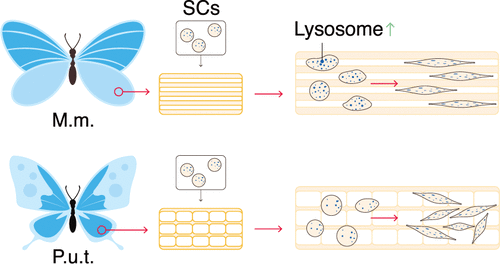Our official English website, www.x-mol.net, welcomes your
feedback! (Note: you will need to create a separate account there.)
Morphology, Migration, and Transcriptome Analysis of Schwann Cell Culture on Butterfly Wings with Different Surface Architectures.
ACS Nano ( IF 15.8 ) Pub Date : 2018-09-11 , DOI: 10.1021/acsnano.8b00552 Jianghong He 1 , Cheng Sun 1 , Zhongze Gu 2 , Yumin Yang 1 , Miao Gu 3 , Chengbin Xue 1, 4 , Zhuoying Xie 2 , Hechun Ren 1 , Yongjun Wang 1 , Yan Liu 1 , Mei Liu 1 , Fei Ding 1 , Kam W Leong 5 , Xiaosong Gu 1, 4
ACS Nano ( IF 15.8 ) Pub Date : 2018-09-11 , DOI: 10.1021/acsnano.8b00552 Jianghong He 1 , Cheng Sun 1 , Zhongze Gu 2 , Yumin Yang 1 , Miao Gu 3 , Chengbin Xue 1, 4 , Zhuoying Xie 2 , Hechun Ren 1 , Yongjun Wang 1 , Yan Liu 1 , Mei Liu 1 , Fei Ding 1 , Kam W Leong 5 , Xiaosong Gu 1, 4
Affiliation

|
It has been shown that material surface topography greatly affects cell attachment, growth, proliferation, and differentiation. However, the underlying molecular mechanisms for cell-material interactions are still not understood well. Here, two kinds of butterfly wings with different surface architectures were employed for addressing such an issue. Papilio ulysses telegonus (P.u.t.) butterfly wing surface is composed of micro/nanoconcaves, whereas Morpho menelaus (M.m.) butterfly wings are decorated with grooves. RSC96 cells grown on M.m. wings showed a regular sorting pattern along with the grooves. On the contrary, the cells seeded on P.u.t. wings exhibited random arrangement. Transcriptome sequencing and bioinformatics analysis revealed that huntingtin (Htt)-regulated lysosome activity is a potential key factor for determining cell growth behavior on M.m. butterfly wings. Gene silence further confirmed this notion. In vivo experiments showed that the silicone tubes fabricated with M.m. wings markedly facilitate rat sciatic nerve regeneration after injury. Lysosome activity and Htt expression were greatly increased in the M.m. wing-fabricated graft-bridged nerves. Collectively, our data provide a theoretical basis for employing butterfly wings to construct biomimetic nerve grafts and establish Htt lysosome as a crucial regulator for cell-material interactions.
中文翻译:

不同表面结构的蝴蝶翅膀上雪旺细胞培养的形态,迁移和转录组分析。
已经表明,材料的表面形貌极大地影响细胞的附着,生长,增殖和分化。然而,对于细胞-材料相互作用的潜在分子机制仍然不甚了解。在此,采用了两种具有不同表面结构的蝶形翼来解决这一问题。凤蝶(Papilio ulysses telegonus(Put))的蝴蝶翅膀表面由微/纳米凹面组成,而Morpho menelaus(Mm)蝴蝶翅膀则装饰有凹槽。在Mm机翼上生长的RSC96细胞与凹槽一起显示出规则的分选模式。相反,播种在Put翼上的细胞表现出随机排列。转录组测序和生物信息学分析表明,亨廷顿蛋白(Htt)调节的溶酶体活性是确定Mm蝴蝶翅膀上细胞生长行为的潜在关键因素。基因沉默进一步证实了这一观点。体内实验表明,用Mm翼制成的硅胶管可显着促进损伤后大鼠坐骨神经的再生。在Mm翼制成的移植物桥接的神经中,溶酶体的活性和Htt的表达大大增加。总的来说,我们的数据为使用蝴蝶翅膀构建仿生神经移植物并建立Htt溶酶体作为细胞-材料相互作用的关键调节剂提供了理论基础。翅膀明显促进大鼠坐骨神经损伤后的再生。在Mm翼制成的移植物桥接的神经中,溶酶体的活性和Htt的表达大大增加。总的来说,我们的数据为使用蝴蝶翅膀构建仿生神经移植物并建立Htt溶酶体作为细胞-材料相互作用的关键调节剂提供了理论基础。翅膀明显促进大鼠坐骨神经损伤后的再生。在Mm翼制成的移植物桥接的神经中,溶酶体的活性和Htt的表达大大增加。总的来说,我们的数据为使用蝴蝶翅膀构建仿生神经移植物并建立Htt溶酶体作为细胞-材料相互作用的关键调节剂提供了理论基础。
更新日期:2018-08-20
中文翻译:

不同表面结构的蝴蝶翅膀上雪旺细胞培养的形态,迁移和转录组分析。
已经表明,材料的表面形貌极大地影响细胞的附着,生长,增殖和分化。然而,对于细胞-材料相互作用的潜在分子机制仍然不甚了解。在此,采用了两种具有不同表面结构的蝶形翼来解决这一问题。凤蝶(Papilio ulysses telegonus(Put))的蝴蝶翅膀表面由微/纳米凹面组成,而Morpho menelaus(Mm)蝴蝶翅膀则装饰有凹槽。在Mm机翼上生长的RSC96细胞与凹槽一起显示出规则的分选模式。相反,播种在Put翼上的细胞表现出随机排列。转录组测序和生物信息学分析表明,亨廷顿蛋白(Htt)调节的溶酶体活性是确定Mm蝴蝶翅膀上细胞生长行为的潜在关键因素。基因沉默进一步证实了这一观点。体内实验表明,用Mm翼制成的硅胶管可显着促进损伤后大鼠坐骨神经的再生。在Mm翼制成的移植物桥接的神经中,溶酶体的活性和Htt的表达大大增加。总的来说,我们的数据为使用蝴蝶翅膀构建仿生神经移植物并建立Htt溶酶体作为细胞-材料相互作用的关键调节剂提供了理论基础。翅膀明显促进大鼠坐骨神经损伤后的再生。在Mm翼制成的移植物桥接的神经中,溶酶体的活性和Htt的表达大大增加。总的来说,我们的数据为使用蝴蝶翅膀构建仿生神经移植物并建立Htt溶酶体作为细胞-材料相互作用的关键调节剂提供了理论基础。翅膀明显促进大鼠坐骨神经损伤后的再生。在Mm翼制成的移植物桥接的神经中,溶酶体的活性和Htt的表达大大增加。总的来说,我们的数据为使用蝴蝶翅膀构建仿生神经移植物并建立Htt溶酶体作为细胞-材料相互作用的关键调节剂提供了理论基础。











































 京公网安备 11010802027423号
京公网安备 11010802027423号